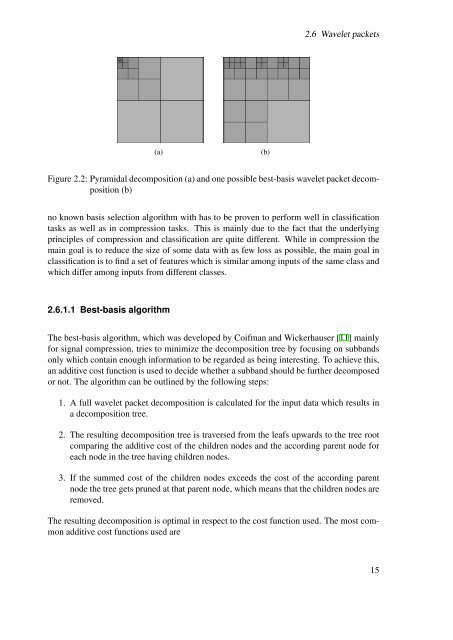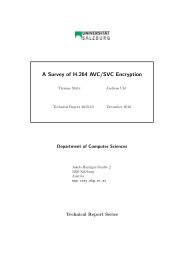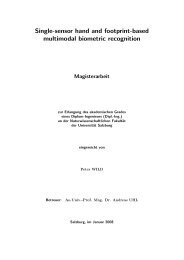Pit Pattern Classification in Colonoscopy using Wavelets - WaveLab
Pit Pattern Classification in Colonoscopy using Wavelets - WaveLab
Pit Pattern Classification in Colonoscopy using Wavelets - WaveLab
Create successful ePaper yourself
Turn your PDF publications into a flip-book with our unique Google optimized e-Paper software.
2.6 Wavelet packets<br />
(a)<br />
(b)<br />
Figure 2.2: Pyramidal decomposition (a) and one possible best-basis wavelet packet decomposition<br />
(b)<br />
no known basis selection algorithm with has to be proven to perform well <strong>in</strong> classification<br />
tasks as well as <strong>in</strong> compression tasks. This is ma<strong>in</strong>ly due to the fact that the underly<strong>in</strong>g<br />
pr<strong>in</strong>ciples of compression and classification are quite different. While <strong>in</strong> compression the<br />
ma<strong>in</strong> goal is to reduce the size of some data with as few loss as possible, the ma<strong>in</strong> goal <strong>in</strong><br />
classification is to f<strong>in</strong>d a set of features which is similar among <strong>in</strong>puts of the same class and<br />
which differ among <strong>in</strong>puts from different classes.<br />
2.6.1.1 Best-basis algorithm<br />
The best-basis algorithm, which was developed by Coifman and Wickerhauser [11] ma<strong>in</strong>ly<br />
for signal compression, tries to m<strong>in</strong>imize the decomposition tree by focus<strong>in</strong>g on subbands<br />
only which conta<strong>in</strong> enough <strong>in</strong>formation to be regarded as be<strong>in</strong>g <strong>in</strong>terest<strong>in</strong>g. To achieve this,<br />
an additive cost function is used to decide whether a subband should be further decomposed<br />
or not. The algorithm can be outl<strong>in</strong>ed by the follow<strong>in</strong>g steps:<br />
1. A full wavelet packet decomposition is calculated for the <strong>in</strong>put data which results <strong>in</strong><br />
a decomposition tree.<br />
2. The result<strong>in</strong>g decomposition tree is traversed from the leafs upwards to the tree root<br />
compar<strong>in</strong>g the additive cost of the children nodes and the accord<strong>in</strong>g parent node for<br />
each node <strong>in</strong> the tree hav<strong>in</strong>g children nodes.<br />
3. If the summed cost of the children nodes exceeds the cost of the accord<strong>in</strong>g parent<br />
node the tree gets pruned at that parent node, which means that the children nodes are<br />
removed.<br />
The result<strong>in</strong>g decomposition is optimal <strong>in</strong> respect to the cost function used. The most common<br />
additive cost functions used are<br />
15








